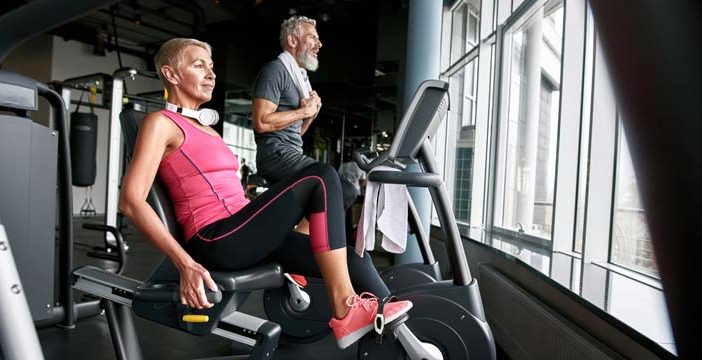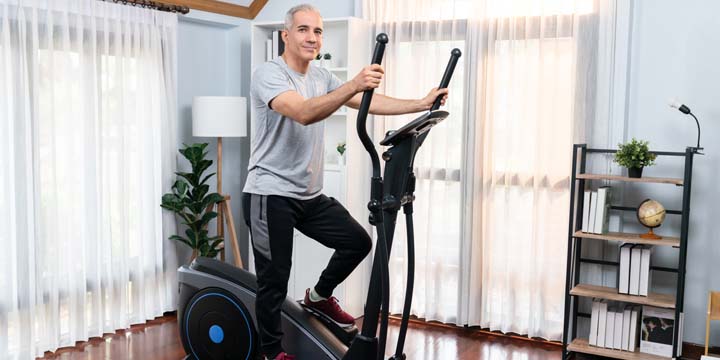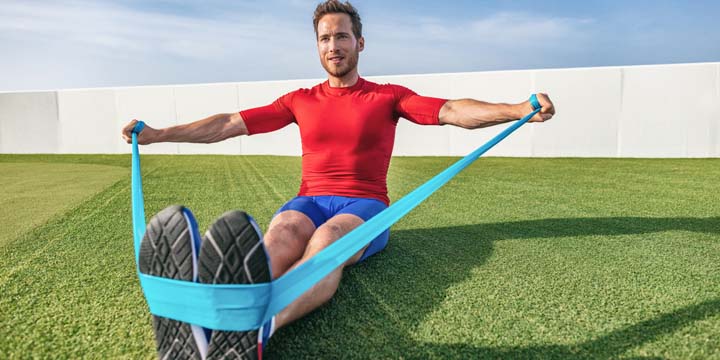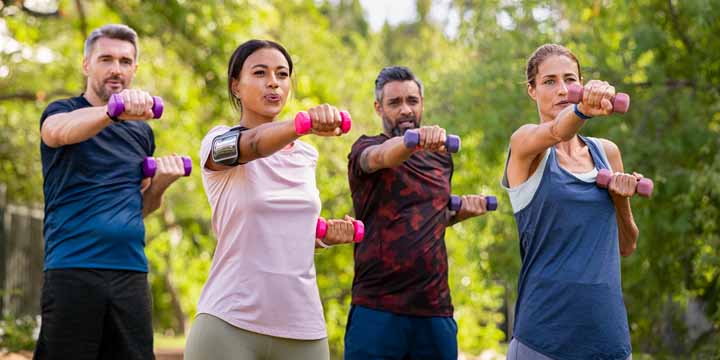
At Diabetes Care Community, a frequent complaint we hear when it comes to starting a fitness program is the overwhelming variety and choice of exercise equipment. It’s hard to know what to buy and how much to spend. We created this handy guide for you to simplify the process.
Exercise equipment generally falls into 2 broad categories: endurance and resistance training. Endurance gear helps you build your heart, lungs and blood vessels, and contributes to metabolic health by improving your blood pressure. Resistance training equipment builds strength, bone density and improves glucose uptake by your muscles.
There are several factors to consider when buying exercise equipment: available space, cost, physical capability, noise level and so on. A large, loud treadmill will work in someone’s basement, but not in an apartment. Here is a quick rundown of the major types of equipment available, and their pluses and minuses.
Endurance equipment
Treadmills
Treadmills are an excellent choice for many, as they mimic walking, the most natural human movement. They vary in size from tiny foldable ones to huge machines you see in commercial gyms. For most people the middle option is ideal: you’ll want something that doesn’t take up half a room, but still has plenty of space and enough power to last for a long time. Look for something with a belt at least 43 centimetres (18 inches) wide and 127 centimetres (50 inches) long. Anything smaller increases the risk of injury.
Look for a treadmill with at least a 2.5 horsepower motor, but more is better. More powerful motors work less hard and tend to last longer. However, they are potentially louder. Definitely try out the treadmill in the store to get a sense of how hard the motor is working and its noise level.
Price is a major consideration for most of us, and with treadmills costing between $250 and $10,000, there are many options. As the price goes up, so do the features and durability. It goes without saying that a $250 treadmill is not going to last forever and that a $10,000 machine is overkill for the vast majority of users. It’s usually not a bad idea to get an extended warranty for a treadmill: they have moving parts as well as lots of electronics, which are very expensive to replace.
Make sure the treadmill you are considering has heart rate monitoring, so you can tell how hard you are working, and an emergency shut-off in case you lose your balance. Most people don’t need complicated programs and “trainer-designed cardio routines” on their treadmill. As well, instead of a big, fancy screen, focus on build quality and power output for your purchase.
Stationary bicycles
Stationary bikes come in 2 styles: upright and recumbent. Upright bikes mimic outdoor cycling with pedals underneath the seat. Recumbent bikes have back support and the pedals are in front of the seat. They have wider, bigger seats and are more comfortable to use for those with back or hip pain.
Cycling has a big benefit over load-bearing activities such as walking or jogging: it reduces impact on the knees. If you suffer from knee issues, a stationary bike may be your best choice for endurance exercise. Like treadmills, bikes come in every price range. Most have electronic displays and a motor that provides resistance.
However, you can also buy bikes that use a simple pressure pad or a hand-adjusted magnet to increase the difficulty. There are no electronic parts and far fewer bits that can break, and you can get a spinning studio-quality bike for a very reasonable price. I highly recommend this option unless you want to track your wattage or difficulty level.
The big advantage of the upright bike is its compactness. Compared to treadmills, ellipticals or recumbent bikes, they take up the least amount of space. There are even ones that fold up so you can shove them under a couch when not in use!
An alternative to a full bike is a pedal exerciser, which is essentially the pedal and drive component of a bike. Most are barely bigger than a basketball and you can find some for as little as $30. If you find sitting on a bike seat difficult and a recumbent bicycle is too large for your space, the pedal exerciser may be your answer. They are an excellent solution if you are just starting out. Another great benefit of the pedal exerciser is that because of its compact size, you can place it on a table and use it with your hands, turning it into an ergometer. A pedal exerciser is also an excellent option if you are wheelchair-bound or if pedaling with your feet is not an option, for whatever reason.
Elliptical machines
Like treadmills and bikes, ellipticals come in a great variety of styles and prices. They provide a smooth, circular movement that eliminates the loading your knees and lower back take when walking, while also allowing you not to sit (unlike a bike). They offer variable resistance and elevation and many have arms that allow you to train your upper body at the same time.
A great variety of elliptical machines are available. Some can be used seated, while others have seats and pedals and double as a bike. Some are quite compact, which eliminates the traditional elliptical’s biggest drawback: its size.
Just like bikes, ultra-compact versions of the elliptical exist. They work roughly the same, so try them both in a store to see which movement style you prefer.

Resistance training equipment
Dumbbells
Free weights are the traditional way to resistance train and the simplest, most compact form of free weights are dumbbells. However, buying a full set of dumbbells can be both costly and space-prohibitive. For that reason, I recommend adjustable dumbbells for most people. They come in various sizes, including smaller options up to 11 kilograms (25 pounds) that go up in 1.3-kilogram (3-pound) increments. This finer increase in weight (the standard is 5 pounds [2.2 kilograms]) allows for more precise adjustment in how much resistance you can use. Dumbbells are a great option if you are just starting, or you’re rehabbing a joint or muscle injury.
Kettlebells
Kettlebells have become very popular over the last decade for their versatility and compactness. However, they require more training to use than dumbbells due to the momentum they generate when used. Kettlebells also come in adjustable weight form, which is also the most cost-effective route: currently an 8- to 40-pound (3.6- to 18-kilogram) adjustable kettlebell is only $30 more than a single 40-pound (18-kilogram) cast iron one and provides far more options for exercise.
Bands
Bands and tubes make a great addition to your resistance training equipment collection. They are easy to store and incredibly versatile. The easiest to use are the tubular rubber bands with handles at the end, which are much more comfortable to hold. A set of 3 of these in light, medium and heavy resistance levels can replace an entire set of free weights.
Resistance bands sometimes come with a neoprene covering. These are often harder to find and can be a bit more expensive, but the covering protects the rubber from light and oxygen exposure, and wear and tear. These bands last much longer than the plain rubber ones.

Yoga mats
Yoga mats are useful for far more things than just yoga! They are great for stretching, rehab/prehab exercises and body-weight resistance training. Yoga mats range in thickness from a few millimeters (¼ inch) to over 15 mm (about ¾ inch). The thicker mats are great for extra cushioning for your knees and back but make keeping your balance harder in yoga poses and single-leg exercises. Pick one that works best for the activities for which you will be using them.
The best gear is the one you will use
Don’t fall into the trap of overbuying gear. You don’t need a treadmill and a full set of weights and kettlebells to get going. Focus on finding the time and making a habit out of exercise. Then you can expand and upgrade your fitness gear as necessary.



